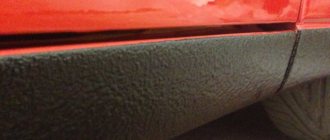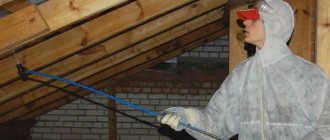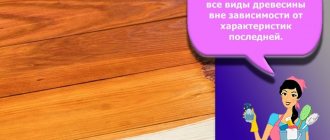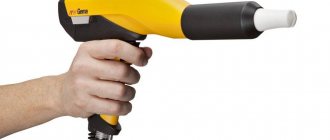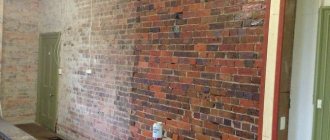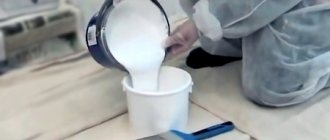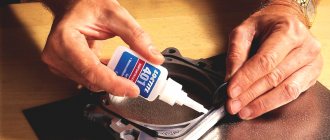Paint and varnish materials used for fire retardant treatment of steel, wood, and in some cases reinforced concrete structures are a new type of similar product that has replaced traditional structural passive fire protection, for example, fire-resistant plasterboard; as well as fire retardant plasters.
Fire-retardant multi-layer coatings - paints, varnishes - make it possible to cover load-bearing building structures, including complex shapes, such as trusses, spans of building coverings, at low consumption; without spoiling their appearance, which is important for architects and designers.
Fire retardant paint on metal structure
Types and scope
Such special coatings perform a double function - they decorate surfaces, like other high-quality paint and varnish products, and reliably protect them from exposure to open fire; high temperature flows; contact with oxygen, preventing metal and reinforced concrete structures from quickly heating up, deforming, and wooden elements of buildings igniting and burning.
There are 2 types of such paints:
- Intumescent paints are the most common group of paints that can increase in volume many times over when the ambient temperature rises, effectively insulating the protected surface from fire and heat.
- Non-swelling , non-expanding even in direct contact with open fire. Their basis is silicates, often called liquid glass, which create a dense film on the protected surface, impenetrable to the heat flow from a developing fire. Their disadvantage is the high consumption of material, approaching fire-retardant plasters, and lower fire-retardant efficiency compared to thermally active paints.
Application area:
- Application on the surface of the load-bearing steel frame of buildings, public and industrial structures - beams, trusses, spans, columns, supports; serving as an effective, modern method of fire protection for metal structures.
- Internal processing of load-bearing structures, building elements made of wood, such as half-timbers, beams, ceilings, columns; panels for finishing walls and ceilings on escape routes and exits. This is a much more effective way of fire protection for wood than fire retardant impregnation.
- Covering of transit ducts of ventilation systems, cable ducts, routes; pipelines of life support systems passing through premises with a high explosion and fire hazard category.
Intumescent fire retardant paint after exposure to flame
Fire retardant compounds with special properties
Intumescent paints based on silicones are the development of the Elox-Prom holding, which specializes in the creation and production of moisture-, fire- and corrosion-resistant materials for extreme conditions. The product line includes fire protection compounds Silotherm EP-6 and SintosilS-61 for metal structures, cables and air ducts, sealants Silotherm EP-120 and Silotherm EP-71.
Silicone compositions are heat-resistant up to 400°C, fire-resistant, not prone to embrittlement and peeling, do not require additional finishing coatings, and are characterized by high dielectric properties. They successfully resist corrosion, ultraviolet and radiation radiation, vibrations, are seismically resistant up to 9 points and retain their properties at 100% humidity and frosts down to -60 °C.
Fire retardant materials based on silicone oligomers have long been successfully used at the enterprises of Rosneft, LUKOIL, Gazprom, and at nuclear power plants (Balakovo, Smolensk, Kalinin, Novovoronezh, Iran and India).
When choosing fire-fighting materials, the main criteria should be the manufacturer’s reputation, available information about the operation of the compositions at specific sites, and reviews from practitioners.
Properties and composition
There is a group of technical standards that determine the fire-retardant effectiveness, testing methods of such paint and varnish products for various types of protected surfaces of structures and products:
- GOST R 53292-2009 – for fire-retardant paints for wood and wood-based materials.
- GOST R 53295-2009 – for metal elements of buildings.
- GOST R 53311-2009 – for cable coverings.
According to these regulatory documents, the fire-retardant efficiency group of metal paints varies from group 1 with a fire resistance limit of 150 minutes to group 7 with a limit of 15 minutes; and for wooden structures, transfer to group G1 is optimal, which allows it to lose no more than 9% of its mass during fire, which serves as maximum protection for wood.
The composition of fire-retardant paints is very diverse, saturated with various chemical components, and in most cases, manufacturers do not disclose it. Like medieval alchemists, their specialists continue to search for more and more effective formulations that are affordable for the production of finished paint and varnish products, but general open information is still available.
Externally, practically no different from other industrial and household paints, fire retardant compositions are mainly produced on a water-based, water-dispersion basis using various polymers, such as acrylates, polyvinyl acetate, butadiene-styrene. This ensures both fire safety in the workplace during fire retardant treatment and no need for personal protective equipment for workers.
There are the following main types of fire retardant paints, differing in their composition and formulation:
- Acrylic one-component thermally expanding paint, the most widely used, combines perfectly with alkyd primer GF-021. It comes in white and gray - these are the two most common colors, universally suitable for public and industrial facilities.
- Water-dispersion paint with PVA - polyvinyl acetate, or water-based with other polymers that form stable emulsions; fillers for which are thermally active graphite, vermiculite, and other mineral materials.
- Moisture-resistant and even weather-resistant fire retardant paint is an epoxy composition on an organic basis using solvents - xylene, white spirit.
Although structural fire protection is considered more effective than applying multi-layer coatings, modern fire-retardant paints have already come close to it in their technical characteristics, which allows architects and designers to think about; and for designers and builders to calculate and erect buildings and structures of large internal volume with a load-bearing metal frame, without deviating from the requirements of fire safety standards.
NON-FLAMMABLE DECORATIVE PAINT AKTERM KM0 (NG)
Non-flammable decorative paint AKTERM KM0 (NG) for escape routes, is made from an inorganic modified aqueous binder, pigments, targeted additives and fillers. After painting, it forms a fireproof and non-toxic coating on the base. It is a silicate paint for interior work.
Description: Fire hazard class of the paint and varnish coating is KM0, flammability is NG, flame spread index is 0. The coating is intended to prevent the spread of fire across the surfaces of restaurants, cinemas, hotels, and other public institutions, for facades and interiors of residential premises, basements and escape routes .
Mandatory and voluntary fire certificates have been obtained for Akterm KM0 coverage Also has a hygiene certificate
Non-flammable decorative paints for interior work are used for painting escape routes in buildings and structures for various purposes and in other cases where the coating should not spread flame. Applied to concrete, gypsum board (plasterboard), plaster, brick, glass wallpaper, wood, stone and other porous building materials.
Long-lasting non-flammable paint AKTERM KM0 has a pleasant smooth silky surface, high resistance to washing, incl. to detergents and disinfectants, high strength, wear resistance. Forms a microporous, breathable, environmentally friendly coating.
| The base color is white, it can be tinted to order in any color. The coating has good hiding power. Non-flammable paint AKTERM km-0 (ng) additionally has antiseptic protection, prevents the appearance of mold fungi and other microorganisms on the treated surface, and contains silver ions. Type: Water-based dispersion paint, fire hazard class of building materials KM0 (NG). Tinting according to the RAL system |
Application order
How to apply fire retardant paint? This question is far from idle, because such special paint and varnish products during the work process have their own differences from household coatings.
Treatment of the protected surface for both external and internal work, including walls and floors, should be carried out several times with thorough drying of each layer of coating.
Applying fire retardant paint to metal structures
There are 4 main stages when working with fire-retardant paints, the correct implementation of which is the basis for success:
- Preparation of the protected surface. This is an extremely important stage, the results of which directly determine whether the fire-retardant coating will serve reliably for years or whether it will peel off and literally fall off the protected building structures in a matter of weeks. The main work at this stage is cleaning the surfaces from layers of previously applied varnishes, paints, and primers; any types of contamination - dust, technological deposits, salts, rust. They use mechanical and/or chemical cleaning methods - this is the use of abrasive power tools, hand tools, sandblasting machines; as well as rust converters, solvents for removing previous paint. After this, the entire protected surface should be thoroughly degreased, for example, with acetone.
- Application of primer has two important objectives - protecting the surface from corrosion and rotting; improving adhesion for subsequent application of a layer of fire retardant paint; reducing the risk of peeling and cracking of the paint layer. Quite often it is recommended to use the universal alkyd primer GF-021, which requires at least three days to dry completely before painting.
- Painting is carried out depending on the complexity of the conditions of the work site, the total area of the metal structures being protected using brushes, rollers or spray guns, and airless spray stations. Painting must be carried out in strict accordance with the manufacturer’s instructions, only then will the fire retardant coating last a long time; and also during the work process, the consumption of fire-retardant paints per 1 m2 will correspond to that stated in the technical documentation; There will be no overspending or unnecessary costs not taken into account in the estimate.
- Applying a finishing coating, most often a fire retardant varnish produced by the same company; or a coating that protects against moisture and ultraviolet rays.
Additional material: Fire retardant varnishes
Specifications
| No. | Indicator name | Meaning |
| 1 | Fire hazard class of paint and varnish coating according to Article 13 and Table 3 of the “Technical Regulations on Fire Safety Requirements” (Federal Law of July 22, 2008 N 123-FZ)* | KM0 |
| 2 | Drying time to degree 3 at temperature (20±2) °C, min. | no more than 60 |
| 3 | Mass fraction of non-volatile substances, %, not less | 53 |
| 4 | Film washability, g/m2, no more | 3,5 |
| 5 | Frost resistance, cycles, not less | 2 |
| 6 | Resistance of the film to the static effects of water at a temperature of (20±2) °C, h, not less | 48 |
| 7 | Resistance of the film to the static effects of detergents at a temperature of (20±2) °C, h, not less | 48 |
| 8 | Adhesion, points | 1 |
| 9 | Impact strength, m, not less | 0,5 |
| 10 | Moisture absorption by paint and varnish film, %, no more | 0,5 |
| 11 | Coating resistance to abrasion, kg/µm, not less | 3,0 |
| 12 | Covering capacity, g/m2, no more | 150 |
| 13 | Conditional light fastness, h, not less | 72 |
| 14 | Film hardness according to a pendulum device type M-3, conv. units, no less | 0,35 |
| 15 | Temperature during processing, ºС | not lower than plus 5 |
| 16 | Density at 20°C, g/cm3 | 1,4…1,7 |
| 17 | pH of the environment | 11…12 |
| Requirements for the appearance of the film | ||
| 18 | Mass fraction of non-volatile substances. For paints on acrylic varnish and copolymers, the normal value is in the range of 64-74%. | 52-57% |
| 19 | Paint pH | 6,5 — 9,5 |
| 20 | The hiding power of the dried film also depends on the color of the material: for example, the indicated value is correct for white paint; for colored paint, 120 g/m² may be required. | no more than 100 g/m² |
| 21 | Film resistance to water at a temperature of approx. | +20°С - at least 24 hours (for a non-aqueous dispersion medium - at least 72) |
| 22 | Conditional light fastness | no more than 5% |
| 23 | Grinding degree | no more than 60 microns |
| 24 | The particle size in other types of acrylic paint is allowed | up to 70 microns |
| 25 | Drying time of the film to the third degree | no more than 1 hour |
| 26 | Degree 3 according to GOST 19007-73 means a condition in which the paper does not stick to the coating under a load of 200 g (at +20°C and air humidity 60-70%). | The manufacturer usually indicates the period for complete drying - from 5 to 30 hours. |
| 27 | Life time | 15 or more years |
| 28 | Conditional viscosity | at least 30 s |
| 29 | Material consumption for a two-layer coating. Depends on the absorbency and degree of roughness of the surface being painted. | 200-300 g/m² |
Recommended for use in educational, medical, public and residential buildings. Treatment with non-flammable paint is necessary in premises where, according to regulations, a fire safety class of at least KM0 is established (in accordance with the norms of Federal legislation).
- For interior work:
- High-rise buildings, residential buildings
- Hospitals, schools, kindergartens
- Apartments, offices, catering establishments
- Museums, exhibition complexes
- Train stations, airports, evacuation routes, parking lots, storage facilities, basements
- fuel and lubricants storage facilities
- garage car complexes
- gas stations
- business centers
The process of forming a refractory layer
A layer of fire-retardant paint applied to the surface is indistinguishable from conventional coatings, but when exposed to high temperatures, usually around 350℃, due to its intumescent properties, it begins to behave in an unusual way.
The intumescent properties of fire-retardant paints are the ability to swell, expanding tens - up to 70 times in volume, upon strong heating, forming, in the process of active thermal decomposition, a fire-resistant, heat-insulating coke layer that reliably protects the surface of metal and wood structures from open fire and high temperatures ; as well as from contact with O2, which prevents the combustion process of organic matter.
Fire retardant materials from foreign manufacturers
Foreign-made fireproof paints have an almost impeccable reputation, stable quality, proven recipes, high performance characteristics and are still in demand.
Under the Interpon brand (Akzo Nobel concern, Norway-Netherlands) some of the most durable and highly effective fire-retardant paints are produced: Chartek, Interfine, Interchar.
The products of NULLifire Ltd (Great Britain) have a well-deserved reputation : fire-resistant paints for metal Unitfire WB, Unitfire CH, NULLifire S607HB, NULLifire FS 711 - for metal structures, concrete, drywall, NULLifire S 707-60 - for food production.
The English concern Leighs Paints produces acrylic and epoxy thermally expanding compositions of the Firetex brand with certified fire resistance from 45 to 150 minutes. This fire protection system has been used in the oil and gas and petrochemical industries since the 90s.
The Norwegian company Jotun AS has a good reputation for passive fire protection coatings : compositions of the Steelmaster and Jotachar brands have long been used at Russian processing industry enterprises.
Certificate of conformity
Such an official document, often called a fire safety certificate, is a mandatory accompaniment for any delivery or purchase of fire-resistant paint and varnish products; certifying that this is a quality product that meets the requirements of fire safety standards.
Certification of fire-retardant paint is required both for domestic serial products and for batches of imported fire-resistant coatings. There is no point in purchasing or using fire retardant paints without a fire protection certificate.
Advantages
The period of use of such special paint and varnish products in our country is more than three decades, therefore, based on the accumulated experience, we can draw informed conclusions about the advantages of their use during construction and reconstruction of buildings with metal, wooden structures, and finishing elements:
- These are effective, safe, often universal products, ready for use, supplied to customers in a variety of convenient packaging and containers.
- Several possible application methods - from manual brushes to airless spray stations, which allows you to quickly cover large surface areas of building structures, as well as work in hard-to-reach places, in cramped conditions; for elements that have a complex shape or configuration.
- The coating with fire-retardant paints is thin-layer, therefore, does not exert a significant load on the load-bearing structures of the protected objects.
- Fire-retardant coatings are safe for humans not only under normal conditions, but also during the formation of the fire-resistant layer, without emitting toxic substances.
- A small consumption of material does not lead to a significant increase in the cost of fireproofing work during construction.
We should also not forget about the decorative properties of fire-retardant paints, the use of which can not only help ensure fire safety at facilities, including public places, but also decorate them.
Let's summarize
Manufacturers offer various modifications of heat-resistant paint materials. They differ from each other in temperature conditions, so if you need a high-quality result, you need to choose the product accurately. For equipment that operates with low heat, such as home radiators, you can choose a cheaper option. For stoves, car exhaust systems, barbecues exposed to temperatures up to +800 degrees C, you will need to buy expensive heat-resistant paint. The compositions in cans and aerosols are easy to work with and can be done independently.
Recommendations and selection criteria
First of all, you should decide on the structures of the load-bearing frame of buildings and finishing elements; sections of pipelines, ducts of engineering systems, life support communications of objects, cable routes must be covered with fire-retardant paints in accordance with fire safety standards; and also from what materials they are made.
Only on the basis of such initial data will it be possible to begin selecting the types of fire-retardant paints suitable for a given situation, of which there is a large assortment on the Russian market from dozens of manufacturing companies.
Managers responsible for fire safety of facilities should not rely on their own knowledge in this specific issue that requires experience, but turn to specialists from design organizations; enterprises providing fire safety services, in particular under fire safety outsourcing agreements.
This is all the more relevant because fire retardant treatment should be carried out only by specialized enterprises that have license permits from the Russian Ministry of Emergency Situations, the necessary material and technical base, and experienced workers.
Bottom line
Firstly, the owner needs to provide coating to the main elements of the building, which are required by law. Typically, these are load-bearing elements, pipe lines, electrical communication points, and fire safety elements. Depending on the specifics of the building, additional individual requirements are imposed. After processing the main parts, it is worth tackling the walls. To obtain the highest fire resistance, it is recommended to cover as many surfaces as possible that are at risk. If the owner is interested in the safety of fragile things (small souvenirs, documents), it is worth placing them in a safe, and the safe is inside a box painted with a fireproof compound.
It is recommended to entrust fire safety finishing to specialists whose services are presented in a wide range on the market. Self-painting of surfaces is allowed, but to obtain the best effect, this should be entrusted to specialists. In addition, buildings that have a fixed legal status (government institutions, commercial organizations, entertainment centers) are not allowed to be processed independently. Finishing work regarding safety in such premises is carried out exclusively by professionals with a license for the relevant activities from the Ministry of Emergency Situations. The above requirements are supported by legal regulations, so you should not neglect this recommendation. In addition, specialists offer quality and guarantees that the owner will not receive any benefits if they process it themselves.


